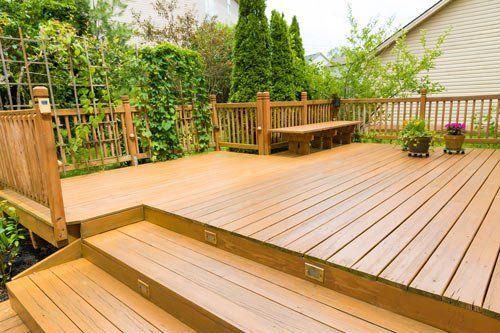
Because your wooden deck is a naturally large, open area, your deck is continually exposed to the elements. Damaging rays of the sun, pounding rain, freezing temperatures, and foot traffic eventually leave a lasting impression on the wood railings, floorboards, and support structure.
If you want to demolish your deck and rebuild, you may be unsure how to proceed. Should you do it yourself or get help? What do you do with the demolition materials? Read on in this simple guide to demolishing your wooden deck to find out.
Start With an Inspection
Armed with the right knowledge, you may be able to perform an inspection of the entire deck. Here are a few signs that probably indicate you only need to make minor repairs:
- Railing system has loose handrails or wobbly posts
- Floorboards that feel slightly soft when you walk on them
- Wood surface is faded, chipped, or peeling
- Small cracks in beams, joists and floor planks
- Presence of termites or minor isolated terminate damage
However, additional signs of damage mean your deck is becoming unsafe or beyond repair and needs to be rebuilt, such as:
- Serious termite tunneling or crumbling, soft wood
- Deep cracks and breaking boards
- Post bases are deteriorated at the concrete blocks or ground
- Damage to where the deck attaches to the home
- Numerous rotting support beams, joists, ledger boards and floorboards
After you take a serious look at your deck and you're not sure what to do, always get an opinion from a professional. They may recommend your deck only needs a few simple repairs rather than a total demolish.
Be Honest About Your Ability Level
After you've tallied up the damage and admitted you need to tear out the deck, you may feel overwhelmed by the job and insecure about doing it all yourself. Be honest about your ability level and get as much or as little help you need. By doing the work yourself, you can save over $1200 in demo costs. However, the savings may not be worth the time and physical effort required to do it yourself.
You may be able to remove all the screws with a drill and tear down a large portion of the structure yourself. If the deck is older and held together with nails instead of screws, the deck may require some more muscle to pull the nails out or pry those old boards up with a hammer and pry bar.
After you remove the entire deck structure off its girders and posts, you will probably encounter concrete footers. These concrete feet were the foundation of the deck posts, keeping the wood away from the wet ground. Depending on the size of the concrete chunk, you might be able to remove them from the ground yourself with a shovel. If they're large or stuck fast, you might need the help of a backhoe and a professional.
Clean Up the Aftermath
Sometimes dealing with the debris pile of old deck materials is as immense a job as the demo itself. If you have a pro do the work for you, they will haul it all away for you. However, if you choose to perform more of the haul away yourself, keep some things in mind.
Resist the temptation to bash away with a sledgehammer. Old weathered wood is in great demand for recycling into rustic furniture or other craft projects. Earn some extra money by selling that old lumber rather than breaking it up.
If selling your lumber seems like too much work, consider donating it. As long as the wood you're letting go is not treated and is free of nails and screws, many establishments like Habitat for Humanity's ReStore will take it off your hands. This allows others to acquire building materials like your old lumber for free or reduced prices.
Demolishing your own deck doesn't have to be difficult or stressful. Tackle what you can and leave the hard part for the professionals. Talk to W R Beach, Inc., for more ways they can help you with your residential demo projects as well as site cleanup.
